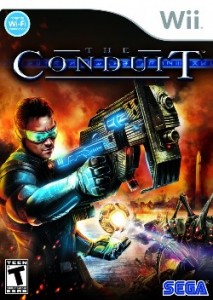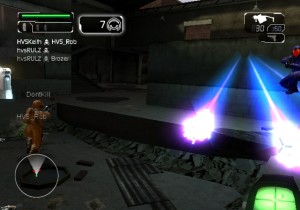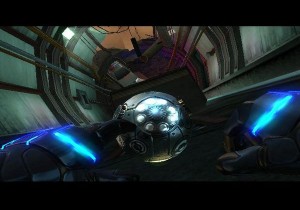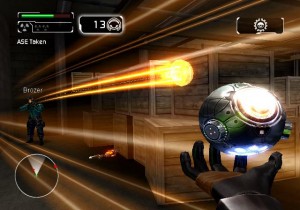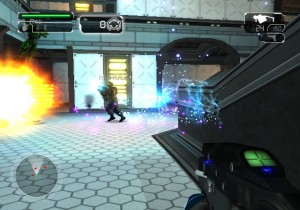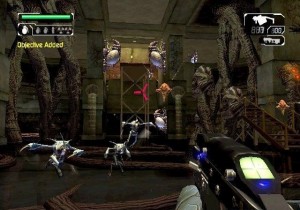Game Info
System: Nintendo Wii
Genre: First Person Shooter/Action
Players: 1 Local, 12 Online
Release Date: June 23, 2009
Publisher: Sega
Developer: High Voltage Software
The excitement surrounding the Wii and its launch was, to put it bluntly, huge. The idea that games could be controlled by the movements of the player was mesmerizing and on top of that the price of admission was cheap. But this bliss faded quickly when Wii owners came to realize that the revolutionary motion controller was not as perfect as many had hoped, the only flawless feature being the Wii’s IR sensor. This sensor, however. would spawn a new following as the possible innovator of the increasingly popular FPS genre, idealistically offering precision aiming and a more natural feeling for shooting than the clunky (albeit improving) dual analog control scheme. Sadly, games came and went and one poorly designed FPS after another went from development to shelf to bargain bin. It has been nearly three years since the Wii’s launch, and the number of FPSs worth playing on the system can be counted on half of one hand. This begs the question, why? Could it be that the Wii is simply so underpowered that it can’t handle the prowess of modern FPS games? Many would have held that as the truth, that is, until High Voltage Software stepped in to take the reigns of the genre and show every other third parties how it’s done.
Seemingly out of no where, High Voltage Software (herein referred to as “HVS”) decided that it was time to do something about the Wii hardcore situation. Known for developing games like Hunter: The Reckoning and its spinoffs, High Voltage has had little experience delving onto Nintendo systems aside from licensed games and a few disappointing WiiWare titles. As such, many were skeptical about The Conduit at first, doubting how far that HVS could push the Wii. As it turned out, however, the game raised the bar for Wii third party titles, and for Wii owners it became the highest quality shooter available on the system thus far in its life. But for everyone else, it’s merely a fun FPS romp worthy of a purchase despite a few flaws.
Immediately after starting the single player campaign, the game throws you into the story with a pre-rendered “cut-scene” of photographs and papers documenting the events leading up to the start of the campaign, all voiced over by Mark Sheppard, the man behind the main character, Michael Ford. The backstory, at first, seems pretty generic, but also a bit intriguing. Mysterious viruses, government conspiracy, unusual weather patterns, alien invasions: It’s all here. Every single clichéd sci-fi storyline (save for zombie infestation, but they’re saving that for The Grinder) is taken straight out of the oven and is combined into a plot that can be called nothing short of average. From the characters to the enemies, to the setting to the execution, everything is standard cookie-cutter science fiction. Yet in this case that is neither a good thing nor a bad thing. You are Michael Ford, secret service agent extraordinaire and the only one who can stop a massive alien invasion in Washington D.C. How can one man accomplish such a feat? Simple, with the help of a high-tech suit, high-tech weapons, and a secret organization called “The Trust”, whom you work for. The vast majority of the story is told at the beginning of missions through chats with the leader of the organization, similar to those found in the likes of Metal Gear Solid and Resident Evil 4. Though they are relatively predictable, the often high quality voice acting keeps the game from getting too dull, though you wouldn’t be missing out on too much if you simply skipped over them.
In terms of gameplay, the single player doesn’t really stand out either. As stated before, almost everything is pretty average for the story mode. You start in one area, move to another, kill enemies, and repeat. The only feature that really stands out as being original is the “All Seeing Eye” or “A.S.E.” This handy high tech device actually allows players to do a variety of things, from hacking computers to seeing invisible enemies. At some points the device gets a bit annoying, emitting a loud beeping sound whenever you go near a hidden object, but all in all it served to be an all-too underused device that could’ve had some very cool gameplay mechanics had they implemented it correctly.
Something I do find odd about The Conduit’s story is the amazingly detailed background with hidden messages and easter eggs. Scattered around various levels are invisible messages that can only be deciphered via the A.S.E., and even then the odd use of language and seemingly made up words will be all but gibberish to those that don’t have any sort of outside knowledge. These messages vary in age and give insight as to just how big this conspiracy really is. If HVS would have simply included these very hidden but very cool bits of information in the main story, The Conduit may have gained significant points for originality, not to mention that there’s just something awesome about hidden messages.
One thing that you will enjoy about The Conduit’s single player is how nice the game looks. Running on HVS’s Wii-specific “Quantum3” engine, the game’s textures are crisp and detailed, environments looks smooth and polished, and overall the quality of the immediate visuals is quite high. As you progress through the game, however, you’ll notice a few things that diminish the high standard set by the first few frames. In many places, this visual prowess is upheld, flaunting some amazing visual effects and textures, but in others, the game is downright dull and ugly, such as the pre-rendered D.C. backgrounds and the textures on walls and floors. While this is a disappointment in many respects, there is no doubting that what HVS has done certainly raised the bar for third party Wii titles, showing off effects like bump mapping, reflection, refraction, motion blur, and many other impressive visual spices, many of which have not looked this good on Wii until now. There are even a few moments where you need to blink a few times before realizing that you are indeed playing a Wii game, and not one on a more powerful console. Without a doubt this is the biggest technical achievement on the system, and one that likely took insurmountable amounts of effort.
Sadly, amidst the excitement of seeing the real limit that the Wii can be pushed to graphically, the game disappoints in another aspect: AI. Throughout the campaign you’ll be faced with many enemies, from standard foot-soldiers to beasts that hold a striking resemblance to giant enemy crabs, and all of them share one thing in common: They’re stupid. It may seem a little crude to use such a word, but it really is the unfortunate truth. HVS praised their custom built engine for having the best visuals on Wii and strikingly realistic AI, but alas, the latter of the two turned out to be almost the opposite. While enemies do hide behind cover and flank the player, they do so in ways that make them easy to pick off. For instance, larger enemies will stand behind a short wall for safety, but unfortunately they weren’t programmed to crouch, move around, or do anything else that would save them from a few carefully placed sniper shots or a flurry of bullets from your SMG. Even if you shoot them, then enemy will simply stand there, continuing their mindset (if it can be called that) that they are indeed behind cover, and therefore safe. Arms, legs, and sometimes even heads will stick out from cover, making them easy targets for your various weapons and armaments.
While the single player campaign isn’t by any means revolutionary, it does offer a good challenge if you raise the difficulty. By default, the game is quite easy, so if you want a good challenge it’s necessary to make the game harder. Thankfully there are 3 choices more intricate than the default, so no matter your skill level you’ll have a good, but taxing time with the game. On the standard settings, the game clocks in at around 10 hours of straight play if you include deaths and restarts, but this can be anywhere from 5 hours to 20 depending on the level of difficulty you chose. For instance, I played through on the second hardest difficulty, and was stuck so often that my death-enhanced playtime was somewhere closer to 17 hours, as opposed to 10.
Something that concerns both the single player and the multiplayer (and the best feature in the game) is the control scheme. As you expect from any modern Wii shooter, the default controls are phenomenal. The developers took the time to make everything feel as natural and smooth as possible in order to give you the best playing experience possible. Then, after they got everything to work exactly how they thought it should, they opened the controls for you to tinker around with. You can change anything and everything to fit exactly what you want, from bounding box to turn speed to cursor sensitivity to vertical look distance; it’s all 100% changeable to fit your needs perfectly. Of course, this short list is but a glimpse of what you can mess around with, but believe me, once you get those controls just right, it feels fantastic. Certainly, not only are the Wiimote IR controls customizable, you can also change the button layout. Nearly any button/action can be mapped to any other button/action, so there’s no fumbling to get used to controller layout in addition to the “feel” of the IR. In addition, the HUD itself can also be changed, allowing you to move icons around to wherever you want, and to change the transparency of it to anywhere from 100% to 0%, essentially playing without a HUD at all.
The point that needs to be made is this: The Conduit’s controls are nothing short of revolutionary. Never has an FPS (or any game, for that matter) offered as many control customization options as The Conduit and never has a shooting game felt this good to play. You don’t have to get used to The Conduit; The Conduit will get used to you.
The single player in The Conduit isn’t by any means revolutionary, but the multiplayer is really the shining point of the game and while it’s not as good as something you’d get on 360 or PS3 it is by far the best online shooter on Wii. Actually, in a few ways it surpasses the big guns of the genre like Halo and Call of Duty.
Moving into the online, everything looks as clean and polished as the rest of the game. Menus are nice, colors meld well, and nothing looks awkward or misplaced. This visual cleanliness is continued into the lobby system, options menus and everything else about the multiplayer visually. Even the in-game multiplayer graphics don’t seem to take much of a hit compared to what you’ll see in the single player, continually boasting highly detailed character models and gun animations, as well as crisp, detailed environments that look even better than some of what you’ll see in the campaign.
However, the framerate does take a hit. Rather than the 30 FPS standard of the campaign, the multiplayer runs at around 25 or so, which is a real disappointment for those who are looking for a really smooth performance online. Unfortunately, the lack of smoothness doesn’t end there for the multiplayer. Matches often have bits of lag, however small and unnoticeable it may be, and this coupled with the slower frame rate can often make the game feel a little bit on the aged side, albeit not in a way that really hinders the gameplay.
Yet another hapless “feature” of the multiplayer is the return of the infamous friend codes, which, sadly, are present in The Conduit. Thankfully, High Voltage has made them as easy to work with as Nintendo would let them, allowing players to add friends that are already present in their Wii system without having to input their Conduit-specific code, eliminating the hassle of finding out and inputting the long string of numbers into the game for some of your friends. Even so, the hindrances of the approach to online play are as frustrating as they’ve always been and something that really should be investigated for HVS’s future titles.
As much of an annoyance as some parts of the multiplayer can be, one thing that is simply satisfying is the matchmaking system. Getting into games is fast and easy, exactly how you’d want it to be on any system. There are three areas of play (Regional, Worldwide, and Friends), three game types, (Free for All, Team Reaper and Team Objective) and many different game modes to chose from in each category. Each player votes on a map, game type, and weapon set, and (much like Mario Kart Wii) the game chooses one from each category based on the number of votes it received. The more votes a choice receives, the higher chance that it will be played, and vice versa. Of course, you have your standard Deathmatch and Capture the Flag modes, but there are a few obscure game types as well, such as A.S.E. Football, in which the players fight to hold onto the A.S.E. in a giant game of keep-away. The most notable mode is Bounty Hunter, a mode completely original to The Conduit and one of the most entertaining game types I’ve played in an FPS.
One aspect that really grabbed me personally about The Conduit’s online multiplayer is the fact that it doesn’t really take itself seriously. It is clear that the folks at HVS were not trying to make a flashy, explosive, action-oriented cinematic experience (the draw of every single modern FPS), but rather a purely fun experience eerily reminiscent of some of my favorite shooters like 007: Nightfire and Perfect Dark. The Conduit treats itself as a game, and that’s something that many titles are lacking nowadays.
Another feature that gives The Conduit an aura of Goldeneye-goodness is the map design, which is not only similar to that of Goldeneye, but is also some of the best I’ve seen in any first person online game I have ever played. It only features seven maps, but they are seven maps of intense firefights, insane ambushes and some all around ridiculous moments. Maps like Complex and Bunker are corridor areas, very reminiscent of those found in Perfect Dark, whereas locations such as Streets and Pentagon are more open maps and each one is expertly crafted to fit exactly what the game intended. These aren’t maps that you’ll look back on when asked and say, “Wow, those maps are pretty good.” These are maps that you’ll be actively praising while playing because the quality is both astounding and obvious.
Much like the maps, the weapons work very well together online and – while not as actively astounding as the maps – feel very satisfying and easy to use, while offering a very good variety. You have your standard SMGs and shotguns, but weapons such as the hi-tech TPC Launcher and the Drudge Striker Rifle provide players a wide array of options to chose from and they’re all a blast to use. There are even a few Wiimote-specific weapons that take advantage of the unique capabilities of the Wii’s controller.
Something that isn’t satisfying, however, is the glitches in the multiplayer, some of which literally can render the game unplayable. Aside from bits of lag here and there, there have been complaints across the country regarding many bugs in the online play, from those that are understandable to one that I consider simply unacceptable. This particular glitch brings the player into a game, but has them spawned under the map with limited HUD, one fourth of the normal reticule, and no way to point or move. Now, this wouldn’t be a huge deal if one could simply leave the game and join another (since the matchmaking process is twice as fast as those found on other consoles), but the bug also eliminates the ability to pause the game and quit. This leaves the player with two options: Wait until the end of the match and everything will be fine, or shut of the Wii and start the game up again. Both of the options are a major annoyance and something that really should be fixed with a patch or an update of sorts, but until then they cannot simply be ignored, and the game takes a major hit because of it.
Regardless, it is clear that HVS was longing to create the best online experience on Wii, and at the end of the day, I believe they did that. WiiSpeak is supported, though unfortunately it is only usable with friends and friends of friends, but even so, it’s a welcome addition and I can tell you from experience that it works very well, with little to no echo at all. In this respect, High Voltage Software treated the Wii like a gaming console, rather than a weak, smaller system.
The Conduit has a lot of phenomenal ideas and many facets to keep the player interested. Unfortunately, the way the game is presented is slightly under par, and as the result the creative ideas and high points of the game almost drown in the mediocrity of the execution. Online glitches and bugs are part of this, but shoddy AI and occasionally unpredictable visual quality make up a larger part. If the development team could have simply added another coat of polish to the game before release, The Conduit would really be one of the better FPSes on the market today, Wii or otherwise. Even with that said, while some would consider The Conduit an average FPS anywhere else, it is a highly recommended Wii game with a few notable and stellar features.
Overall: 8.1/10
You’ll like this game if:
You own only a Wii
You’re FPS obsessed
You’ve been longing for the spiritual successor to Perfect Dark 64 or GoldenEye
You won’t like this game if:
You own another system, but aren’t obsessed with FPSes
Dislike FPS games entirely
